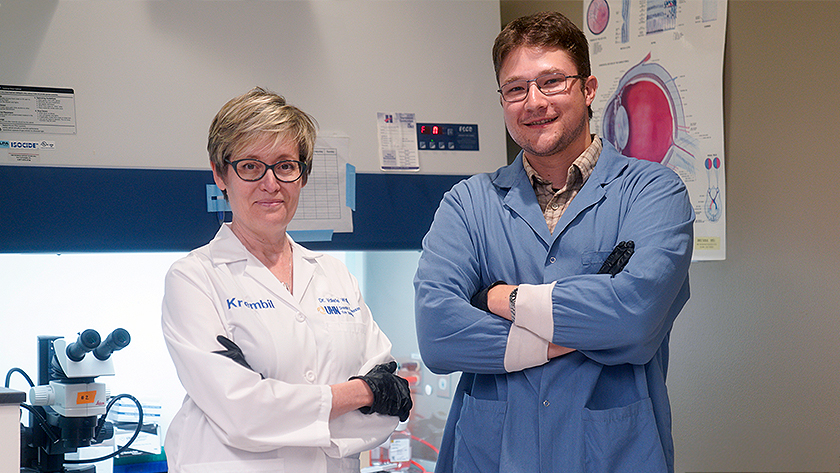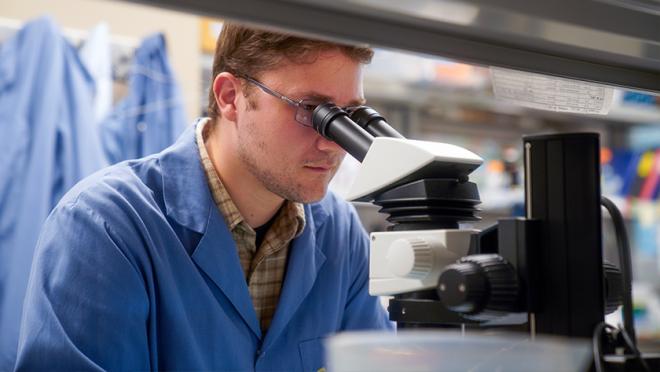
Researchers at UHN’s Donald K. Johnson Eye Institute (DKJEI) have discovered a pivotal role of macrophages—a type of immune cell that destroys invading microorganisms—within the membranes that envelop and protect the brain in anti-cancer cell signalling.
It is commonly believed that gene mutations within precancerous cells are sufficient to trigger uncontrollable tumour growth and metastasis—but this is not the case.
It fact, it is quite difficult for tumours to form and grow. This challenge results from biological roadblocks that either exist within precancerous cells (e.g., molecular pathways that turn off cell division) or come from nearby healthy cells, such as immune cells.
For cancer cells to flourish, they need to co-operate with healthy cells in their environment. This process is a constant push-pull, with tumours continually receiving chemical signals that promote or inhibit their growth.
In a recent study published in Developmental Cell, a team of UHN scientists has brought to light a key cell population and chemical signalling pathway that inhibit the development of brain tumours.
According to Dr. Valerie Wallace, Co-Director and Senior Scientist at DKJEI and the lead author of the study, we can think of a developing cancer like a smoldering fire. “Early stage tumours are akin to embers that fail to cause fires because they are smothered by factors in their environment,” she explains. “This smothering often succeeds in extinguishing the embers, but they can burst into flames if sufficient fuel becomes available.”
The cells and processes that smother early tumours are clinically relevant for cancer screening and treatment. Screening tests such as colonoscopies are aimed at detecting precancerous lesions so they can be removed before they progress, and drugs that mimic or bolster natural anti-tumour processes can help prevent or treat cancers.
“Because we cannot biopsy brains to screen for early stage cancers the way we do elsewhere in the body, there are a lot of unknowns related to anti-cancer cell signalling in this tissue,” says Dr. Nenad Pokrajac, a postdoctoral researcher in Dr. Wallace’s lab and the first author of the study.
To overcome this limitation, the team used an experimental model of medulloblastoma—the most common type of cancerous brain tumour in children—to study how non-tumour cells affect tumour formation in a particular brain region called the cerebellum.
“From previous studies, we knew that blood vessels in the cerebellum can have anti-tumour effects, but these vessels interact with many partners,” says Dr. Pokrajac. “Our goal was to pinpoint the cells that work with blood vessels to inhibit tumour growth.”

The sophisticated experimental model enabled the team to track the division of cancer cells in response to changes in cell signalling.
The team discovered that the meninges—the tissues that line the surface of the brain and spinal cord—are powerful cancer fighters.
Of the many cell types present in the meninges, macrophages stood out as key players in the fight against tumour development. When the researchers removed these cells or inhibited their activity, tumours grew faster.
“We also discovered that macrophages attack early tumours by releasing a protein called CXCL4, which inhibits a powerful growth-promoting protein called CXCL12,” explains Dr. Pokrajac. “Based on these findings, blood vessels instruct macrophages that reside in the meninges to release CXCL4 to smother tumours by depriving them of fuel.”
Importantly, because macrophages can be found throughout the meninges, their protective role is likely not specific to the cerebellum, or even to a particular type of tumour.
More research is needed to confirm whether this is the case, but the team’s findings raise the possibility that these cells play a general, widespread role in the development of brain tumours.
“This is an exciting step forward for understanding how brain tumours form and how we can leverage the body’s natural cancer-fighting processes to treat them,” concludes Dr. Wallace. “In many tissues, it can take years for tumours to develop. If we can identify the processes that keep tumours at bay, and how they can go awry, we can intervene early and improve patient outcomes.”
The work was supported by the Cancer Research Society, the Canadian Institutes of Health Research, the Natural Sciences and Engineering Research Council of Canada, the Ontario Institute for Regenerative Medicine, the Government of Ontario, the University of Toronto-UHN Vision Science Research Program, Medicine by Design-University of Toronto, Foundation Fighting Blindness and the UHN Foundation. Dr. Valerie Wallace is DKJEI Co-Director and Senior Scientist and a Professor in the Department of Ophthalmology & Vision Science at the University of Toronto. She holds the Donald K. Johnson Chair in Vision Research at UHN and a Tier 1 Canada Research in Retina Regeneration at the University of Toronto.
Pokrajac NT, Tokarew NJA, Gurdita A, Martinez AO, Wallace VA. Meningeal macrophages inhibit chemokine signalling in pre-tumour cells to suppress mouse 1 medulloblastoma initiation. Developmental Cell. 2023 Sept 28. doi: 10.1016/j.devcel.2023.08.033.




